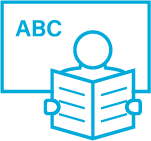Does early reading instruction promote the rate of acquisition? A comparison of two transparent orthographies

This study explored the development of children’s reading skills in two transparent orthographies: Estonian and Finnish. Despite Estonian children had formal reading instruction one year earlier and thus better reading skills at the beginning of school, fluency and reading comprehension skills were at the same level across both groups by the end of first grade.
Authors: Piret Soodla, Marja-Kristiina Lerkkanen,Pekka Niemi, Eve Kikas, Gintautas Silinskas & Jari-Erik Nurmi
Source: Soodla P., Lerkkanen, M.-K., Niemi, P., Kikas, E., Silinskas, G., & Nurmi, J.-E. (2015). Does early instruction promote the rate of acquisition? A comparison of two transparent orthographies. Learning and Instruction, 38, 14–23. DOI: 10.1016/j.learninstruc.2015.02.002
This study explored the development of children’s reading skills in two transparent orthographies: Estonian and Finnish. Formal reading instruction begins one year earlier in Estonia than in Finland. Despite Estonian children having better reading skills at the beginning of school, fluency and reading comprehension skills were at the same level across both groups by the end of first grade. Thus, an earlier start to reading instruction in transparent orthographies does not necessarily offer any long-term advantage.
- The development of reading skills is influenced by children’s pre-reading skills and several underlying cognitive antecedents, as well as teaching practices in literacy instruction.
- The timing of when proper literacy instruction commences can also have different short- and long-term effects. Although the importance of early reading instruction in kindergarten has been emphasised, there are doubts concerning its benefits for children’s later reading development.
- The optimal age for reading instruction may also depend on the language.
Learning to read in different languages
- Regularity and transparency of correspondence between phonology and orthography significantly affect reading in the early phase of literacy acquisition.
- Some orthographies are shallow with consistent grapheme–phoneme correspondences; others are deeper in the sense that they contain more inconsistent correspondences as well as morphological influences on spelling.
- Beginning readers using deep orthographies experience greater difficulties in decoding and a slower rate of development than those using shallower orthographies.
- The Estonian and Finnish languages share a common origin and share much in common in terms of phonology, syntax, morphology, and lexicon.

The study
The present study compared the development of children’s reading skills during the first school year in two languages with highly transparent and linguistically related orthographies: Estonian and Finnish. Estonian children are expected to have basic decoding skills before their entrance into primary school, whereas in Finland, formal literacy instruction begins in the first grade.
- Estonian children are expected to know all Estonian letters and be able to read and spell one- and two-syllable words before they begin school.
- Finnish kindergarten education should create a foundation for literacy skills, but children’s reading skills are not explicitly taught. About 30% of students are decoders at the beginning of school in Finland.
Participants were 433 Estonian children from 22 different classrooms and 353 Finnish children from 137 different classrooms. The participants were in the first grade at school and all had attended kindergarten. Pre-reading skills (letter knowledge and phoneme awareness) were assessed in September. Word reading skills were assessed in both September and April, and reading comprehension was assessed in April.

Findings
Beginning of the first grade
- Estonian students performed better than Finnish students in letter writing, phoneme blending, and decoding.
- Estonian children performed better than Finnish children in word recognition and word reading fluency.
End of the first grade
- Finnish students performed better than Estonian students in word recognition and word reading fluency.
- Word reading accuracy was high in both the Estonian and Finnish samples.
- Reading comprehension did not differ between Estonian and Finnish children.
Summary
- Despite Estonian children beginning formal reading instruction one year earlier at the age of 6, both Estonian and Finnish children’s reading skills were largely comparable by the final semester of first grade.
- Estonian children had better pre-reading and decoding skills as well as word recognition and fluency skills than Finnish children at the beginning of their first year at the age of 7.
- Finnish children’s reading skills developed to a greater extent during the first grade.
- Reading comprehension was at a similar level for Estonian and Finnish children at the end of the first grade.

Implications
Because of the fast rate of acquisition of decoding skills in transparent orthographies, linguistic comprehension has a greater influence on reading comprehension at the end of the first grade than decoding. Because Finnish children’s listening comprehension and inference-making skills are both strongly supported during kindergarten and first grade by shared reading and other activities with texts, we expect that these activities might also support the development of reading comprehension. Early reading instruction does not necessarily offer any long-term advantage for further success in reading development at school in transparent orthographies. However, support for children’s general language skills and motivation toward letters and books in kindergarten (as well as overall classroom quality and the phoneme-based reading instruction at grade 1) might play a more significant role in the development of emergent reading skills.